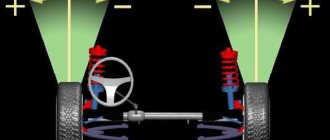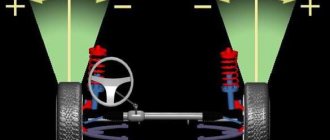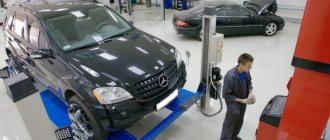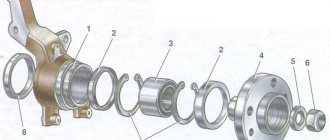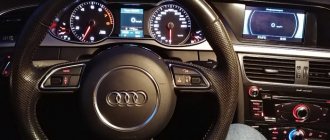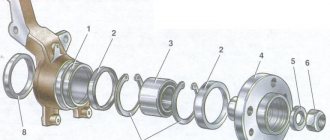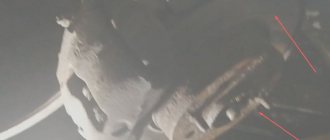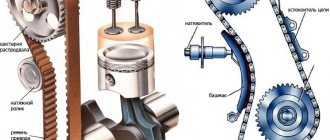Why does my car pull to the side when braking?
Faulty brakes can cause uneven distribution of braking force on the vehicle's wheels.
When your car pulls to one side when braking, there is most likely a problem with the brake system. There are several problems that can cause this:
- Worn brake cylinder
- Brake pads contaminated with grease or fluid
- Stuck caliper or wheel cylinder piston
- Bad automatic adjuster on your rear drum brake or parking brake
- Airy brake system with unbleeded brakes
- Uneven wear on your car's brake pads
Sometimes, however, the problem has nothing to do with the braking system at all: drag during braking can also be caused by a faulty tire or loose or worn suspension components.
Whatever the reasons, driving with bad brakes is always dangerous. This guide can help you determine the cause of the problem through a series of quick tests and diagnostics that you can use at home to solve common problems with this system.
How to start troubleshooting the problem
First, ask yourself: is this a problem with the front or rear brakes?
Typically, when a problem occurs with one of the front brake systems, you will feel a lot of tension on the steering wheel when you press the brake pedal.
However, when the problem is caused by one of the rear brake mechanisms, you may not notice the traction unless you brake. When braking hard, one of the tires will slide and squeal because it will lock up. Sometimes when the rear brake assembly is bad, you may not notice traction at all, but you'll know there's a problem when you notice uneven tire wear.
This preliminary diagnosis can help you find problems faster. Once you know which side is giving you trouble, it's a good idea to look at the opposite side as well to get a general idea of the condition of your brakes on all wheels.
WHY THE STEERING STEERING PULS TO THE LEFT OR RIGHT: MAIN REASONS
The driver of the car must monitor the proper operation of all systems of the car in order to minimize the risk of a traffic accident due to the failure of one of them. For travel safety, special attention must be paid to the braking system and steering. If the slightest signs of their malfunction appear, you need to immediately diagnose and fix the problem.
A typical problem that all drivers have to face when using a car for a long time is the spontaneous tendency of the steering wheel to turn to the side, thereby deviating the car from the chosen course. If the steering wheel pulls to the right or left, there could be many reasons for this. Within the framework of this article, we will look at what is causing the problem and why the steering wheel pulls when braking or accelerating.
Common causes: pulls to one side when braking
In the following sections, I discuss how you can spot these potential problems and how to resolve them.
- Contaminated brake pad
- Uneven brake wear
- Brake fluid leak
- A stuck piston in the caliper or wheel cylinder
- Rear brake adjuster faulty
- Different pressure in car tires
Check the brake pads for contamination.
Why does it pull to the side when braking – Dirty brake pad
Brake pads or linings contaminated with fluid or grease will prevent the brake assembly on that side of the system from operating properly.
- Check the suspected front or rear brake assemblies by raising and supporting the vehicle securely on jack stands.
- Remove the wheel assembly.
- Check the brake pad and rotor (front brakes) or pads and drum surface (rear brakes) for grease, oil, or other foreign matter.
- You may need to look for leaks or contamination.
- Make repairs and replace the pads or caliper if necessary.
Check caliper operation.
When braking, the car pulls to the side – Uneven brake wear
Brake pads and drums should wear gradually and at the same rate on each side, just as brake pads and drums should brake gradually and at the same speed.
But problems with this system can cause this unit on one wheel to wear excessively compared to the unit on the opposite wheel, causing braking force to be distributed unevenly across the wheels.
Inspect both front or rear wheel assemblies for uneven wear. Excessive brake pad or rotor wear on one side may be a sign of problems with the entire system that need to be further investigated.
Test your brakes to find and fix the problem.
If you are dealing with uneven wear on your brake pads, rotors or drums, check:
- stuck caliper piston
- jammed wheel cylinder piston
- Loose or stuck fastening hardware - check the tightness of the bolts on all connections of the brake system of your car
- for proper lubrication of the caliper and pin, see the video below
Refer to your vehicle's repair manual. If you don't already have a manual, you can find one on the Internet or in specialized auto stores.
Check for fluid leaks around the hydraulic lines, exhaust valve and caliper piston.
Messages 7
1 Topic by shirbk 2013-12-16 23:32:20
- shirbk
- New member
- Inactive
- Registration: 2013-12-16
- Messages: 3 Thanks : 0
- Car: VAZ 21103
Topic: Car pulls to the right, camber is normal
Hello. The problem is that the car pulls to the right, so you have to keep the steering wheel turned to the left. The car (21103, 2003, mileage 230,000) was purchased in March, it pulled, but almost not noticeably, so it didn’t bother me. I decided to do the SR, it didn’t help, it remained the same, but since it didn’t pull much, I scored. I drove until I decided to repair the chassis. I changed the struts, supports, levers, silent blocks, caps, calipers, silent blocks of the rear beam, changed the balls maybe a couple of months before (I didn’t change it myself, maybe they changed something else but I forgot). I went to do the alignment (to another office), and again I didn’t like it. But again, I didn’t really decide that the roads were crooked and it really didn’t always pull, sometimes it pulled, sometimes it didn’t, and sometimes it could start to lead a little to the left, but this is rare. I changed my shoes for the winter and after a while I noticed that there were almost no spikes left on the front right wheel along the outer edge. Again I went to the breakdown in another city, the master said that almost everything was normal, turned the nuts and everything on the computer turned green like OK. On the way home, I again couldn’t figure out whether I was pulling or not. A couple of days ago I went on business for 130 km and on the way back (I noticed it was when I was driving from there) I had to hold the steering wheel almost 35-40 degrees to the left in order to go straight, but then as I entered my area (30 kilometers to my house) it became better and the steering wheel began to turn to the left a little as usual and pulls a little. What could this be? The car doesn't seem to be damaged; some friends looked at it; I tried changing the wheels from left to right, but it didn't help on the summer tires (directional in the summer, asymmetrical in the winter), the pressure is normal, the wheel alignment is supposed to be the same, the summer tires haven't been eaten up, the winter tires aren't visible yet. Help me please.
2 Reply from Wolfy36 2013-12-17 08:34:18
- Wolfy36
- New member
- Inactive
- Registration: 2013-12-12
- Messages: 19 Thanks : 5
- Car: VAZ 21120
Re: Car pulls to the right, camber is normal
shirbk – The car doesn’t seem to be in a bit of a state, some friends looked at it
I would “sin” against your friends - by all indications, the body is driven, and not badly driven, take it to a service station and look at the geometry of the body. since it’s unlikely to be anything else, try the “moose” test, drive up to 60 km (on an empty, flat road.) let go of the steering wheel and squeeze the brake, if it pulls to the right - PPC body (but in fact everything is clear - once SR normal, but eats rubber)
3 Reply from [email protected] 2013-12-17 09:40:49
- [email protected]
- New member
- Inactive
- Registration: 2013-11-18
- Messages: 23 Thanks : 6
- Auto: 21120
Re: Car pulls to the right, camber is normal
I had this happen because of the tires, and the tires were new. I also suffered with the car pulling to the side, it’s especially annoying on long roads, it’s not a pleasure to drive, but it’s stressful. I also went to a wheel alignment and did it three times in a row. to the poor dismantler until he installed it perfectly. He showed me the second and third time on the monitor that everything was perfect. The tires were changed from the rear to the front, since the guides did not roll in an X-shape. He sinned on the tires, but I stubbornly did not want to believe this. In general, I drove with the car slightly diverted to the side. Winter came, I went to them to change shoes, they took off the summer ones, put them on winter ones, installed the wheels on the car, talked to them about how it drives the same way leading to the side. I left them, drove out of town and strangely the car didn’t pull to the side, everything was perfect, I realized that the problem was in the tires. I sold the tires, the one I took off (the problematic one), winter was over, I got castings from the garage with tires, the front one was bald and eaten away at the edges. Even with such tires, it drove smoothly. As the wrecker told me, this could be due to crooked tires, a small spring, or a blow to the car from the top. I’ve seen driving a broken car to the wrecker , on two cars, and each time the demolition guy told me about the problem and that there was not enough degree for the wheel alignment, he asked me to fix this, this, that. Therefore, I think if your car bit is critical, that after the wheel alignment you are pulled to the side , the wheel alignment specialist could tell you that the car has swerved and it’s not possible to properly set the wheel alignment. I’m sinning on the tires. + Is the rubber (air) still leaking?
Car pulls when braking – Brake fluid leak
A leaking caliper piston or wheel cylinder will prevent this unit from working properly and will cause improper braking force tension.
Checking the brake caliper
Check the front wheel assemblies by lifting the tires off the ground and securely supporting the vehicle on jack stands. A leaking caliper piston will most likely need a new seal or replacement, but you should also check the piston and cylinder for damage.
Corrosion is usually behind this type of leak. If you haven't changed your brake fluid in more than two years, moisture is likely affecting the sealing surfaces inside the caliper.
It is possible to rebuild the caliper assembly if the cylinder is not too worn or damaged, but it is usually better to simply replace the caliper with a new assembly. If you want to rebuild the caliper, follow the procedure outlined in your vehicle's repair manual. You need to sharpen the cylinder and replace the seal and boot.
Checking the rear wheel cylinder
Checking the rear wheel cylinder is similar to checking the caliper piston for leaks:
- After removing the wheel and drum, check around the cylinder for leaks. If necessary, replace or restore the wheel cylinder.
- If you decide to rebuild the cylinder:
- Make sure the cylinder, pistons, compression spring and expanders are in good condition.
- Sharpen the cylinder and replace the rubber cups.
- Follow the instructions in your vehicle's repair manual.
- Replace the brake fluid in the system.
Check the disc rotors for corrosion and contamination.
Rear brake adjuster
The rear wheel brake assembly can also fail when the brake adjuster becomes stuck or fails. Brake shoe adjusters must maintain the correct distance between the brake shoe linings and the drum as the linings wear. Most vehicles use a sprocket (screw) type mechanism for the adjuster, while some modern vehicles may use a latch type mechanism for the adjuster.
- Raise and securely support the vehicle on a stand.
- Remove the wheel and drum.
- Check for free movement of the regulator.
- Consult the repair manual for your specific vehicle model to repair or replace the regulator if necessary.
Faulty tire and belt layers can also cause the brakes to stretch.
Pulls to the right when accelerating, pulls to the left when braking – Faulty tires
If you don't find a problem with the vehicle pulling to the side while braking, a quick tire can save you time and possibly money.
Problems can arise with the layers or belts that make up the inner body of the tire. Although it is difficult to determine if a tire has internal problems, simply by doing a visual inspection, you can swap the front and rear tires and see if the brake problem goes away. If this happens, the problem is most likely in the tire itself.
Lada 2114 2003 - breakdown
Cars for sale
Lada 2114 Samara, 2011
Lada 2114 Samara, 2011
Lada 2114 Samara, 2012
Lada 2114 Samara, 2007
Comments 29
I also found it on the forums.
Why does it pull to the right? Knowledgeable people say that the engine sank. This is noticeable - the left side of the engine (if you look at the car) has gone down a little. This is a misalignment of the rotation axis of the drives. Extra load on the internal CV joints.
People recommend replacing all three supports with new ones.
What do you people think, can this happen?
In general, the same garbage appeared. Coasting - everything is perfect. You press on the gas and it pulls to the right. I thought and thought.
“Difference of drives” is a scam for suckers. In order for efforts to be exerted to twist the drive, you need acceleration like a McLaren in Formula 1
The following applies here:
1. The rubber in the daisy of the left lever was flattened - hence the play appeared. 2. The same thing happened with the tires of the left crab. 3. The daisy nut is loose
Let's ask the question - why exactly the LEFT?
It's simple - I travel mostly alone. The left wheel has more grip on the ground. In general, the load is greater on the left wheel.
3. Since free movement of the left wheel suspension has appeared, the car axle CHANGES ITS POSITION relative to the body - THE LEFT WHEEL WHEN ACCELERATING - MOVES A LITTLE AHEAD.
1. Tighten the daisy nut. 2. Tighten the lever nut near the body
3. Replace the left “crab”
The crabs are changed in pairs; if one crab goes away, the castor will go away and it will be necessary to regulate it.
It won't go away! There is a steel bushing inside the rubber. The rubber ages and wears out due to the longitudinal movement inside the crab cage. When braking and picking up speed, the castor “walks”.
From the factory, I had a pull to the right when accelerating and even in neutral, the tires were hitting the outside. The alignment was ideal, the car was new, I stopped by and did diagnostics, everything was ok. I swapped the wheels and started pulling to the left. all because of the rubber. tires white 100. then I threw the rear wheels on the front. I was driving fine, but the inside part was already damaged. The rack also knocks from the factory. Now either I’ve caught a hole or the camber has somehow miraculously gone wrong, but now the right wheel is even visually turned to the right and the left one is straight. The steering wheel is turned 2-3 degrees, the car pulls heavily. Plus, at 110 km/h the steering wheel probably hits a hole. In general, it should pull a little when accelerating. due to the difference in drive length, weight and diameter.
After fixing brake and tire problems, check the suspension
With the help of the guide above, you can check the most common problems that lead to braking conditions before taking your car to the workshop. However, if looking at the list of common brake problems does not provide a good diagnosis, check for loose or worn suspension parts that could be causing the problem, such as damaged bushings or loose or worn hardware on the lower control arm, tie rod, ball joint, spacer or torsion bar, depending on the specific model. Refer to your vehicle's repair manual to check these components. And finally, watch a video about checking the car’s brake system and eliminating typical and common faults.
Why does the car pull to the right when driving?
If the car starts to pull to the right, do not rush to go to the service station. First, inspect the wheels and check the tire pressure. Perhaps the problem can be solved by using a pump or replacing the wheel.
The pull to the side is most noticeable when driving in a straight line: you let go of the steering wheel - the car pulls to the right , as a result you have to hold it or constantly steer to maintain the correct trajectory. This usually indicates problems with the suspension or steering . If the car starts to pull to the right after driving through potholes, the wheel alignment angles are most likely off. In this case, the problem can be eliminated by adjusting the wheel alignment - the average cost of such a service is from 800 rubles per axle.
It is recommended to do wheel alignment twice a year and each time after repairing the chassis.
If the car pulls to the right after a wheel alignment, the problem is most likely due to an incorrect procedure. In this case, you need to go back to the service station and report the problem. It is better not to delay this, since the guarantee for adjustment work usually does not exceed 7 days.
In cases where the car pulls to the right, the cause may be not only incorrect adjustments or critical wear of the suspension and steering elements, but also a violation of the body geometry as a result of an accident, damaged wheel or brake discs.
Owners of cars with high mileage are more likely to experience the fact that the car pulls too far to the right due to worn parts. But even on relatively new cars, similar problems are possible when the scheduled deadline for replacing chassis components is approaching or has already been missed. For example, silent blocks and shock absorbers often wear out after 40,000–50,000 km when driving on uneven roads.
If the tires and wheel alignment are normal, but the car pulls to the right and the steering wheel shakes while driving, you need to look for the cause in the steering. A broken rack, loose tips or rods lead to the wheels gaining greater freedom of movement relative to the steering wheel. If slip and runout are observed only when braking, it is worth checking the condition of the brake mechanisms. The cylinders or caliper guides may have become sour.
All the main reasons why the car pulls to the right are listed in the table:
| Reasons for the car pulling to the right | Why does this happen? | How does it manifest itself? | How to fix |
| Incorrect wheel alignment | Driving on bad roads, hitting potholes | The car pulls to the side if you don't touch the steering wheel. To drive straight, you have to constantly steer | Carry out a wheel alignment at a service station. Price: from 800 rubles for a passenger car |
| Incorrect repair or replacement of suspension and steering components | |||
| Wear and deformation of suspension and steering elements | Replace faulty elements, adjust wheel alignment | ||
| Transmission problems | Incorrect drive repair (for example, lack of lubrication in the CV joint or wear) | The car pulls to the side, and on a jacked-up car, one drive wheel rotates manually with more force than the second, a “grenade” crunch is possible | Check that the transmission repair has been carried out correctly. If the car pulls to the right after replacing the CV joint on the left side (or vice versa), the second CV joint also needs to be replaced, and if it pulls to the side where the new part is installed, there is a high probability of incorrect repairs or defects |
| Differential fault | Even if I did the wheel alignment, the car still pulls to the right. When spinning the wheels on a jacked axle, extraneous sounds are heard from the differential | Diagnose and repair differential | |
| Broken wheel alignment during transmission repair | The car pulls to the right on a flat road, you can only keep the direction by holding the steering wheel in the opposite direction to the shift | Get a wheel alignment done at a service station | |
| Uneven tire pressure | Tire puncture | The car is noticeably pulled to the side when moving in a straight line, on smooth asphalt the noise of the tires on one side increases, the wheel goes over small bumps more smoothly, but large holes hit the disc harder than usual | Seal the puncture, equalize the pressure in all wheels |
| Nipple allows air to pass through | Replace the spool or nipple assembly, equalize the pressure | ||
| Poisons the joint between a tubeless tire and a rim | Clean the plane of contact between the disc and the rubber, lubricate it, re-seat it. If the tires are worn out, replace the tires. | ||
| Wheel bearing wear | Natural development of friction surfaces | The car pulls to the right with normal wheel alignment and good tires. While driving, a crunching, knocking, grinding or howling sound is heard from the wheel, which intensifies as the speed increases. The jacked wheel has play in both the vertical and horizontal planes | Replace wheel bearings |
| Dirt getting into the lubricant due to a leaky oil seal and subsequent wear of the friction surfaces | |||
| Brake jamming | Wear and/or deformation of discs/drums | Even after wheel alignment, the car pulls to the right when you press the brake pedal, uneven braking is observed | Replace damaged and worn elements of the brake system, bleed the brakes |
| Wedging the caliper | |||
| Clogged/pinched brake lines or hoses | |||
| Uneven tire wear | Long-term driving with an unadjusted wheel alignment or with heavily worn suspension parts | They did the camber, but the car pulls to the right in the same way, or even stronger, than before. When driving on a flat road, there is a tendency to slightly yaw and/or shakes and vibrations that radiate to the steering wheel. If the car pulls to the right after changing tires, the tires may have become deformed due to improper storage. | Eliminate the root cause of uneven tire wear and replace them with new ones |
| Tire deformation due to improper storage conditions | |||
| Crooked disks | Road accident | Once in a hole, the car pulls to the right, there are noticeable vibrations and beating in the steering wheel even at low speed, the car does not obey the steering wheel | If there are minor deformations, restore the disc on a high-quality rolling machine. If the core of the disk has moved and there is a “figure eight” pattern when rotating, replace the crooked disks with new ones |
| Hitting a pothole or hitting an obstacle at speed. Unskilled rolling of discs to level out dents | |||
| Violation of body geometry | Road accident | After an impact, the car pulls to the right; upon visual inspection, changes in the gaps between body elements may be noticeable, and sometimes there are problems with closing the doors (creaks, jamming, incorrect operation of locks, etc.). If corrosion and fatigue are to blame, the body “walks”, there are severely rusty and rotten areas | Measure control distances (preferably on a workshop bench), restore the geometry of parts damaged in an accident |
| Fatigue and corrosion damage to load-bearing body elements (spars, cups, boxes, etc.) | Recycle rusty or cracked body parts into new ones. |
Sometimes the car pulls to the right while driving simply due to a violation of the weight distribution. For example, if there is a heavy load in the trunk on the right, an obese passenger is sitting on the same side, and only a thin driver is sitting on the left, then even a working car deviates from a straight line. In this case, to correct the problem, you simply need to balance the load by moving the load or asking the passenger to move to the left side.
What to do if the car starts to drift, and is it possible to drive a car that deviates to the side when the steering wheel is released, read on.

